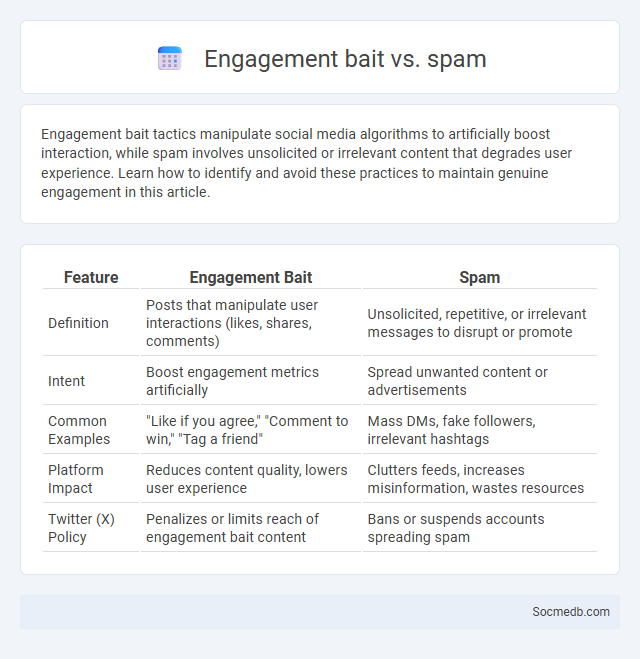
Photo illustration: Engagement bait vs Spam
Engagement bait tactics manipulate social media algorithms to artificially boost interaction, while spam involves unsolicited or irrelevant content that degrades user experience. Learn how to identify and avoid these practices to maintain genuine engagement in this article.
Table of Comparison
| Feature | Engagement Bait | Spam |
|---|---|---|
| Definition | Posts that manipulate user interactions (likes, shares, comments) | Unsolicited, repetitive, or irrelevant messages to disrupt or promote |
| Intent | Boost engagement metrics artificially | Spread unwanted content or advertisements |
| Common Examples | "Like if you agree," "Comment to win," "Tag a friend" | Mass DMs, fake followers, irrelevant hashtags |
| Platform Impact | Reduces content quality, lowers user experience | Clutters feeds, increases misinformation, wastes resources |
| Twitter (X) Policy | Penalizes or limits reach of engagement bait content | Bans or suspends accounts spreading spam |
Defining Engagement Bait: What Is It?
Engagement bait refers to social media content designed explicitly to manipulate algorithms by encouraging users to react with likes, comments, shares, or other interactions. These posts often use phrases like "Comment below," "Tag a friend," or "Share if you agree," aiming to boost visibility artificially. Understanding engagement bait helps you create authentic content that fosters genuine connections without risking penalties from platforms.
Understanding Spam: Key Characteristics
Spam on social media typically involves unsolicited, irrelevant, or repetitive messages designed to mislead or exploit users. It often features suspicious links, excessive hashtags, and exaggerated claims aimed at hijacking your attention or personal information. Recognizing these key characteristics helps protect your online experience from scams and unwanted disruptions.
Engagement Bait vs. Spam: Core Differences
Engagement bait manipulates algorithms by encouraging users to interact through likes, shares, or comments, often leading to lower quality content and reduced reach. Spam, however, involves repetitive, irrelevant, or unsolicited messages that disrupt user experience and can result in account penalties. Understanding these core differences helps you create authentic content that fosters genuine engagement without risking platform restrictions.
Why Platforms Crack Down on Engagement Bait
Social media platforms crack down on engagement bait to maintain authentic user interactions and improve content quality. Algorithms prioritize genuine engagement signals, and posts that manipulate likes, shares, or comments distort user experience and reduce overall platform trust. Removing engagement bait helps prevent spammy content and ensures a more meaningful, relevant feed for users.
Types of Engagement Bait Tactics
Social media platforms often encounter engagement bait tactics such as "Like and Share" prompts, comment soliciting, and reaction-based posts designed to manipulate algorithms for increased visibility. These tactics exploit user interactions by encouraging specific actions that artificially boost post reach and engagement metrics. Understanding these strategies helps you recognize and avoid content that prioritizes viral spread over genuine connection and information quality.
The Impact of Spam on User Experience
Spam on social media platforms severely deteriorates your user experience by cluttering feeds with irrelevant and repetitive content, leading to decreased engagement and frustration. It also poses security risks through phishing attempts and malicious links, undermining trust in the platform. Effective spam detection algorithms and user reporting tools are essential to maintain a safe and enjoyable social media environment.
Negative Effects of Engagement Bait on Reach
Engagement bait on social media manipulates algorithms by encouraging artificial interactions such as likes, shares, and comments, which ultimately lowers organic reach in favor of authentic content. Platforms like Facebook and Instagram penalize posts with engagement bait by reducing their visibility, leading to decreased audience engagement and undermining community trust. This practice disrupts genuine user experience, causing content creators to lose credibility and limiting meaningful interactions across social networks.
Detecting and Avoiding Spammy Practices
Detecting and avoiding spammy practices on social media requires vigilance toward unusual follower activity, excessive posting frequency, and suspicious links that may compromise your account's credibility. Ensuring your content remains authentic and engaging helps maintain organic reach while protecting your brand from penalties imposed by platforms' algorithms for spam behavior. Your active monitoring of interactions and implementing privacy settings fortifies your presence against harmful spam tactics.
Ethical Alternatives to Engagement Bait Strategies
Social media platforms are increasingly promoting ethical alternatives to engagement bait strategies, emphasizing authentic interactions and meaningful content over manipulative tactics. Algorithms now favor posts encouraging genuine conversations, user-generated content, and community-driven engagement, reducing the spread of misleading or clickbait posts. Brands and influencers adopting transparent communication and value-driven messages foster trust and long-term loyalty in digital audiences.
Best Practices for Genuine Audience Engagement
Effective social media engagement relies on authentic interactions, timely responses, and consistent content tailored to the target audience. Utilizing data analytics to understand audience preferences and behaviors enhances content relevance, driving higher engagement rates. Prioritizing community building through meaningful conversations and user-generated content fosters trust and long-term loyalty.
 socmedb.com
socmedb.com